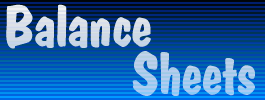|
You know that a business will often owe money to various individuals
or institutions. It might owe its suppliers money for a recent delivery,
the bank for an overdraft or loan and it holds money that was invested
by the owners/shareholders.
The balance sheet helps us look at the debt position of the business
and allows us to see whether or not it is financially secure. For
instance, a business that had most of its debts in the form of an
overdraft that had to be paid by the end of the month is in a worse
liquidity position than one that has its debts in the form of a
loan that doesn't have to be paid off for five years.
We can also look at what the business owns. These items, known
as assets, can be used to pay-off any debts and maintain liquidity.
As well as using the balance sheet to look at liquidity, we can use
it to understand what decisions the managers have taken and what they
could do in the future.
|

